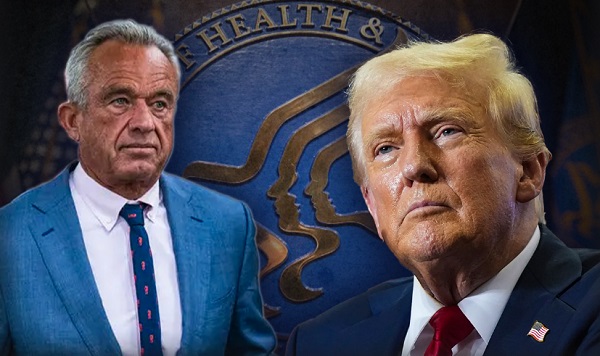Health
Trump signs executive order to ‘make America healthy again,’ address chronic disease

From LifeSiteNews
The order repeatedly underscores the declining health and fitness of America’s children as its number one priority, noting that ‘the health of Americans is on an alarming trajectory that requires immediate action’ and that this ‘applies urgently to America’s children.’
Shortly after Robert F. Kennedy Jr. was sworn in as secretary of the Department of Health & Human Services (HHS), President Trump signed an executive order titled Establishing The President’s Make America Healthy Again Commission (MAHA EO) to investigate and address the root causes of America’s escalating health crisis, with a focus on childhood chronic disease.
Chaired by Kennedy, the commission has four main policy directives to reverse chronic disease: Empower Americans through transparency and open-source data and avoid conflicts of interest in all federally funded health research; Prioritize gold-standard research on why Americans are getting sick in all health-related research funded by the federal government; Work with farmers to ensure that U.S. food is the healthy, abundant, and affordable; and ensure expanded treatment options and health coverage flexibility for beneficial lifestyle changes and disease prevention.
“To fully address the growing health crisis in America, we must redirect our national focus, in the public and private sectors, toward understanding and drastically lowering chronic disease rates and ending childhood chronic disease,” declares the order. “This includes fresh thinking on nutrition, physical activity, healthy lifestyles, over-reliance on medication and treatments, the effects of new technological habits, environmental impacts, and food and drug quality and safety.”
“We must restore the integrity of the scientific process by protecting expert recommendations from inappropriate influence and increasing transparency regarding existing data,” it continues. “We must ensure our healthcare system promotes health rather than just managing disease.”
The MAHA EO comes at a time when many Americans have lost trust in the nation’s healthcare system and are increasingly skeptical as to whether they are receiving honest answers about the causes of the country’s health crisis and how to improve it.
The order repeatedly underscores the declining health and fitness of America’s children as its number one priority, noting that “the health of Americans is on an alarming trajectory that requires immediate action,” and that “This concern applies urgently to America’s children.”
Immediate assessment and strategy to make children healthy again
At the outset, the commission will “advise and assist the President on how best to exercise his authority to address the childhood chronic disease crisis” and within 100 days, will submit to the president its “Make Our Children Healthy Again Assessment.”
Within 180 days, the commission will present a “Make our Children Healthy Again Strategy,” “restructuring the Federal Government’s response to the childhood chronic disease crisis, including by ending Federal practices that exacerbate the health crisis or unsuccessfully attempt to address it, and by adding powerful new solutions that will end childhood chronic disease.”
The order notes that:
In 2022, an estimated 30 million children (40.7 percent) had at least one health condition, such as allergies, asthma, or an autoimmune disease. Autism spectrum disorder now affects 1 in 36 children in the United States — a staggering increase from rates of 1 to 4 out of 10,000 children identified with the condition during the 1980s. Eighteen percent of late adolescents and young adults have fatty liver disease, close to 30 percent of adolescents are prediabetic, and more than 40 percent of adolescents are overweight or obese.
To fully address the growing health crisis in America, we must redirect our national focus, in the public and private sectors, toward understanding and drastically lowering chronic disease rates and ending childhood chronic disease. This includes fresh thinking on nutrition, physical activity, healthy lifestyles, over-reliance on medication and treatments, the effects of new technological habits, environmental impacts, and food and drug quality and safety. We must restore the integrity of the scientific process by protecting expert recommendations from inappropriate influence and increasing transparency regarding existing data. We must ensure our healthcare system promotes health rather than just managing disease.
“Thank you, President Trump, for your leadership, your confidence in me, and your deep concern for the health of the American people,” said Kennedy. “You have truly heard the calls of the millions of mothers who simply want the tools – and the truth – so they can make informed decisions for their children.”
“I have prayed each morning for the past two decades for God to put me in a position to solve the childhood chronic disease epidemic,” Kennedy continued, “and now, thanks to you Mr. President, we will make this promise a reality.”
Fraser Institute
Long waits for health care hit Canadians in their pocketbooks

From the Fraser Institute
Canadians continue to endure long wait times for health care. And while waiting for care can obviously be detrimental to your health and wellbeing, it can also hurt your pocketbook.
In 2024, the latest year of available data, the median wait—from referral by a family doctor to treatment by a specialist—was 30 weeks (including 15 weeks waiting for treatment after seeing a specialist). And last year, an estimated 1.5 million Canadians were waiting for care.
It’s no wonder Canadians are frustrated with the current state of health care.
Again, long waits for care adversely impact patients in many different ways including physical pain, psychological distress and worsened treatment outcomes as lengthy waits can make the treatment of some problems more difficult. There’s also a less-talked about consequence—the impact of health-care waits on the ability of patients to participate in day-to-day life, work and earn a living.
According to a recent study published by the Fraser Institute, wait times for non-emergency surgery cost Canadian patients $5.2 billion in lost wages in 2024. That’s about $3,300 for each of the 1.5 million patients waiting for care. Crucially, this estimate only considers time at work. After also accounting for free time outside of work, the cost increases to $15.9 billion or more than $10,200 per person.
Of course, some advocates of the health-care status quo argue that long waits for care remain a necessary trade-off to ensure all Canadians receive universal health-care coverage. But the experience of many high-income countries with universal health care shows the opposite.
Despite Canada ranking among the highest spenders (4th of 31 countries) on health care (as a percentage of its economy) among other developed countries with universal health care, we consistently rank among the bottom for the number of doctors, hospital beds, MRIs and CT scanners. Canada also has one of the worst records on access to timely health care.
So what do these other countries do differently than Canada? In short, they embrace the private sector as a partner in providing universal care.
Australia, for instance, spends less on health care (again, as a percentage of its economy) than Canada, yet the percentage of patients in Australia (33.1 per cent) who report waiting more than two months for non-emergency surgery was much higher in Canada (58.3 per cent). Unlike in Canada, Australian patients can choose to receive non-emergency surgery in either a private or public hospital. In 2021/22, 58.6 per cent of non-emergency surgeries in Australia were performed in private hospitals.
But we don’t need to look abroad for evidence that the private sector can help reduce wait times by delivering publicly-funded care. From 2010 to 2014, the Saskatchewan government, among other policies, contracted out publicly-funded surgeries to private clinics and lowered the province’s median wait time from one of the longest in the country (26.5 weeks in 2010) to one of the shortest (14.2 weeks in 2014). The initiative also reduced the average cost of procedures by 26 per cent.
Canadians are waiting longer than ever for health care, and the economic costs of these waits have never been higher. Until policymakers have the courage to enact genuine reform, based in part on more successful universal health-care systems, this status quo will continue to cost Canadian patients.
Health
Just 3 Days Left to Win the Dream Home of a Lifetime!

|
|
|
|
|
-

 National2 days ago
National2 days agoCarney promotes MP instrumental in freezing Freedom Convoy donors’ bank accounts
-

 Business2 days ago
Business2 days agoThe carbon tax’s last stand – and what comes after
-

 conflict1 day ago
conflict1 day agoIran nuclear talks were ‘coordinated deception’ between US and Israel: report
-

 illegal immigration2 days ago
illegal immigration2 days agoLA protests continue as judge pulls back CA National Guard ahead of ‘No Kings Day’
-

 conflict2 days ago
conflict2 days agoIsrael strikes Iran, targeting nuclear sites; U.S. not involved in attack
-

 International1 day ago
International1 day agoIsrael’s Decapitation Strike on Iran Reverberates Across Global Flashpoints
-

 Energy1 day ago
Energy1 day agoCanada is no energy superpower
-

 Alberta1 day ago
Alberta1 day agoPunishing Alberta Oil Production: The Divisive Effect of Policies For Carney’s “Decarbonized Oil”










